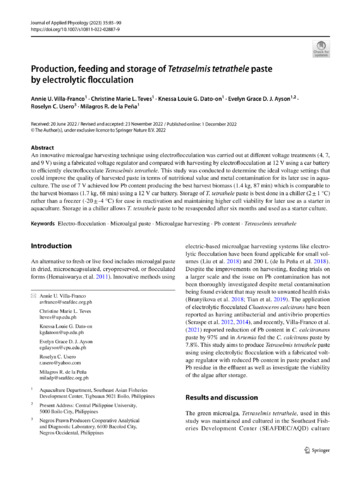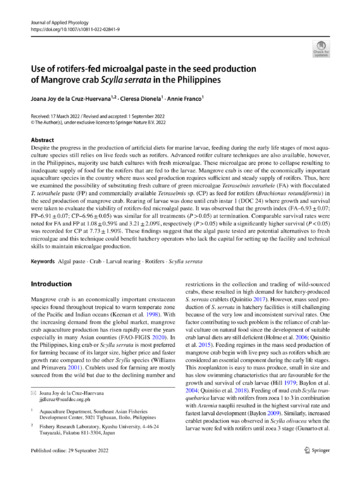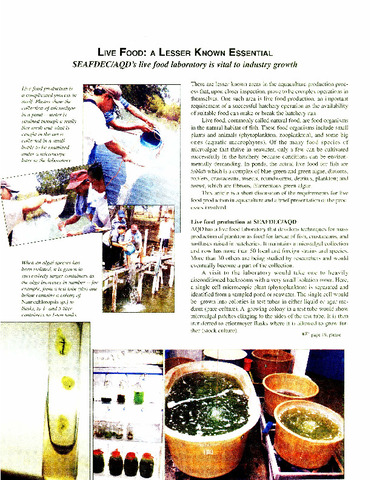Production, feeding and storage of Tetraselmis tetrathele paste by electrolytic flocculation
- Global styles
- MLA
- Vancouver
- Elsevier - Harvard
- APA
- Help

View/
Date
2023-02Author
Page views
963ASFA keyword
AGROVOC keyword
Taxonomic term
Metadata
Perlihat publikasi penuh
Share
Abstract
An innovative microalgae harvesting technique using electroflocculation was carried out at different voltage treatments (4, 7, and 9 V) using a fabricated voltage regulator and compared with harvesting by electroflocculation at 12 V using a car battery to efficiently electroflocculate Tetraselmis tetrathele. This study was conducted to determine the ideal voltage settings that could improve the quality of harvested paste in terms of nutritional value and metal contamination for its later use in aquaculture. The use of 7 V achieved low Pb content producing the best harvest biomass (1.4 kg, 87 min) which is comparable to the harvest biomass (1.7 kg, 68 min) using a 12 V car battery. Storage of T. tetrathele paste is best done in a chiller (2 ± 1 °C) rather than a freezer (-20 ± -4 °C) for ease in reactivation and maintaining higher cell viability for later use as a starter in aquaculture. Storage in a chiller allows T. tetrathele paste to be resuspended after six months and used as a starter culture.
Keywords
Electro-flocculation Microalgal paste Microalgae harvesting Pb content Tetraselmis tetratheleSuggested Citation
Villa-Franco, A., Teves, C. M. L., Dato-on, K. L. G., de Jesus-Ayson, E. G. T., Usero, R., & de la Peña, M. R. (2023). Production, feeding and storage of Tetraselmis tetrathele paste by electrolytic flocculation. Journal of Applied Phycology , 35(1), 85-90. https://doi.org/10.1007/s10811-022-02887-9
Type
ArticleISSN
0921-8971; 1573-5176Koleksi
- Journal Articles [1258]
Related items
Showing items related by title, author, creator and subject.
-
Use of rotifers-fed microalgal paste in the seed production of mangrove crab Scylla serrata in the Philippines
Despite the progress in the production of artificial diets for marine larvae, feeding during the early life stages of most aquaculture species still relies on live feeds such as rotifers. Advanced rotifer culture techniques ... -
Acute toxicity of water-accommodated fraction and chemically enhanced WAF of bunker C oil and dispersant to a microalga Tetraselmis tetrathele
Santander-Avancena, Sheryll ; Sadaba, Resurreccion
; Sadaba, Resurreccion  ; Taberna, Hilario S., Jr.; Tayo, Gilma T.; Koyama, Jiro (Springer Verlag, 2016)
This study assessed the toxicity of water-accommodated fraction (WAF) and chemically enhanced WAF (CEWAF) of bunker C oil and dispersant (DISP) to a microalga, Tetraselmis tetrathele. The 72-h median effective concentration ...
; Taberna, Hilario S., Jr.; Tayo, Gilma T.; Koyama, Jiro (Springer Verlag, 2016)
This study assessed the toxicity of water-accommodated fraction (WAF) and chemically enhanced WAF (CEWAF) of bunker C oil and dispersant (DISP) to a microalga, Tetraselmis tetrathele. The 72-h median effective concentration ... -
Live food: A lesser known essential
Surtida, Marilyn B. (Aquaculture Department, Southeast Asian Fisheries Development Center, 2003)This article is a short discussion of the requirements for live food production in aquaculture and a brief presentation of the processes involved.





